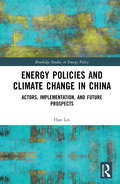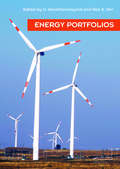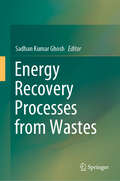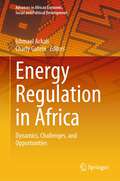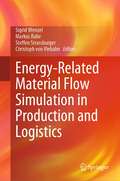- Table View
- List View
Energy or Extinction?: The Case for Nuclear Energy (Routledge Revivals)
by Fred HoyleOriginally published in 1977 and as second edition in 1979, this book argues that without energy sources on a vast scale our present society cannot survive. According to the author, Fred Hoyle, the technology to tap solar, wind or wave power on a large enough scale just does not exist. He considers nuclear fission to be the only source currently capable of supplying our needs. The author fills in the scientific background necessary to appreciate his arguments in his lucid, direct style, so that the book can act as an ideal introduction for those unfamiliar with the energy debate. This short book is unashamedly provocative and many of the central tenets of it remain as relevant today as when it was first published.
Energy Performance in the Australian Built Environment (Green Energy and Technology)
by Priyadarsini Rajagopalan Mary Myla Andamon Trivess MooreThis book examines energy efficiency in the Australian built environment and presents current developments with a particular focus on the temperate setting of Victoria state. It is divided into four main parts discussing policies, climate, and carbon footprint and presenting case studies on the energy performance and indoor environmental quality of various building types. The book is intended for readers wanting to understand the various policies related to different buildings types and their energy performance.
Energy Performance of Buildings: Energy Efficiency and Built Environment in Temperate Climates
by Sofia-Natalia Boemi Olatz Irulegi Mattheos SantamourisThis book analyzes the trends and technologies of green and energy efficient building, identifying strategies for implementing energy savings and enabling the use of renewable resources in residential, commercial, healthcare and educational building sectors. The authors focus on best practices in temperate climates, providing in-depth coverage of urban heat island, climate change and fuel poverty mitigation through architectural optimization, leveraging renewable energy sources and utilization of cutting-edge cooling materials. Pragmatic emphasis is placed on improving the energy performance of existing building stock to meet short and long term objectives of climate and energy conservation strategies. Engineers, architects, designers, students, policy makers and efficiency professionals will all gain valuable insights and ideas from this practical handbook to greening the built environment.
Energy Policies and Climate Change in China: Actors, Implementation, and Future Prospects (Routledge Studies in Energy Policy)
by Han LinIn the face of growing environmental challenges, including climate change and energy security, countries across the globe are developing new policies and programs to address these challenges, and China is no exception. This book analyses China’s two most significant climate-related energy policies, the Clean Development Mechanism (CDM; including the later Chinese Certified Emission Reduciton – CCER) and the Energy Conservation and Emission Reduction Scheme (ECERS). This work specifically examines the strengths and weaknesses of these policies to highlight the deficiencies and advise how they can be optimised, so China can better achieve its emission reduction goals. It analyses the roles and relationships between relevant actors and identifies how successful their cooperation has been, and what factors have affected it. Importantly, the work draws on a wide range of sources from central ministries to civil society, including interviews with Chinese officials, scholars, energy company managers, environment non-govermental organisation (ENGO) personnel, media reports, and online forum discussions. In doing so, the book not only analyses the thoughts of policymakers, as many works do, but also those implementing the policies and those impacted by the policies. The book concludes by offering detailed and practical solutions to address each specific deficiency in the CDM and ECERS policies, with the aim of providing innovations and alternative approaches to improve current and future policies in China. This book will be of great interest to students, scholars, and policymakers interested in climate change, energy, and Chinese environmental policy and politics.
Energy Policies and Climate Change in China: Actors, Implementation, and Future Prospects (Routledge Studies in Energy Policy)
by Han LinIn the face of growing environmental challenges, including climate change and energy security, countries across the globe are developing new policies and programs to address these challenges, and China is no exception. This book analyses China’s two most significant climate-related energy policies, the Clean Development Mechanism (CDM; including the later Chinese Certified Emission Reduciton – CCER) and the Energy Conservation and Emission Reduction Scheme (ECERS). This work specifically examines the strengths and weaknesses of these policies to highlight the deficiencies and advise how they can be optimised, so China can better achieve its emission reduction goals. It analyses the roles and relationships between relevant actors and identifies how successful their cooperation has been, and what factors have affected it. Importantly, the work draws on a wide range of sources from central ministries to civil society, including interviews with Chinese officials, scholars, energy company managers, environment non-govermental organisation (ENGO) personnel, media reports, and online forum discussions. In doing so, the book not only analyses the thoughts of policymakers, as many works do, but also those implementing the policies and those impacted by the policies. The book concludes by offering detailed and practical solutions to address each specific deficiency in the CDM and ECERS policies, with the aim of providing innovations and alternative approaches to improve current and future policies in China. This book will be of great interest to students, scholars, and policymakers interested in climate change, energy, and Chinese environmental policy and politics.
Energy Policies for Sustainable Development Strategies: The Case of Nigeria (Frontiers in African Business Research)
by Nnaemeka Vincent EmodiIn this book, a number of long-term energy scenarios are developed for Nigeria considering the impact of vital factors that may influence energy policies in the country’s future energy system. The energy scenarios were developed through the Long-Range Energy Alternatives Planning System (LEAP) model. The model identified the future energy demand and supply pattern using a least-cost combination of technology options while limiting the emission of greenhouse gases. The book presents four scenarios, and key parameters considered include GDP, households, population, urbanization and the growth rates of energy-intensive sectors. Further, it highlights the findings of the cost-benefit analysis, which reveal the costs of implementing selected policies and strategies in Nigeria, including those focusing on energy efficiency and fuel/technology switching. The book also discusses the application of the LEAP-OSeMOSYS Model in order to identify lowest-cost power plants for electricity generation. Some sustainable strategies that can ensure a low carbon development in Nigeria are also explored on the basis of successful country cases in relation to the Nigerian LEAP model. As such, the book will help policy makers devise energy and sustainable strategies to achieve low carbon development in Nigeria.
Energy Policies in the European Union: Germany’s Ecological Tax Reform
by P.J.J. Welfens B. Meyer W. Pfaffenberger P. Jasinski A. JungmittagGlobal warming is a serious threat to the stability of world climate and to economic prosperity in some regions. The book offers a theoretical analysis which focuses on double dividend issues. Moreover, the ecological tax reform in Germany and the options of modern energy policy are described and evaluated. The volume presents innovative model simulations and analyzes, in the context of the model, the benefits of a modified tax reform, based on a Schumpeterian approach. Finally, implications for the European Union and other countries are discussed.
Energy, Policy, and the Environment: Modeling Sustainable Development for the North (Studies in Human Ecology and Adaptation #6)
by Marja Järvelä and Sirkku JuholaThis book sets the questions of energy and the environment in the North in the global context and further addresses historical developments, views on energy taxation and tariffs, and effects of EU energy policy. Climate change appears more frequently than ever on the top of global and national policy agendas. In the current situation traditional environmental concern and environmental policy may not suffice in the face of the global challenge as manifested by climate change and the depletion of fossil energy resources. But as new data comes to light, new energy policies and changes in economic structures are crucial for putting into action global climate policy. Crucial tasks in environmental policy are the sustainable utilisation of natural resources and the conservation of natural and human-made habitats. One of the areas of the world where this comes into play the most is in the Nordic countries. Northern societies are predominantly high tech, high consumption and high energy supply societies. And with the transition from older energy sources (wood for heating and stream water for power production) to newer ones (oil and nuclear energy) discussions on the environmental impact have led to public and corporate action. The Northern countries have been at the forefront in finding sustainable alternatives to solve conflicts arising from the rise in energy needs. However, these countries have taken different pathways with different policies in attempting to achieve this. As the needs and concerns from climate change arise, a Northern dimension, involving policies that contrast to European and global trends, emerges. Energy, Policy, and the Environment: Modeling Sustainable Development for the North explores that dimension.
Energy Policy Modeling in the 21st Century (Understanding Complex Systems)
by Hassan Qudrat-UllahThe roles and applications of various modeling approaches, aimed at improving the usefulness of energy policy models in public decision making, are covered by this book. The development, validation, and applications of system dynamics and agent-based models in service of energy policy design and assessment in the 21st century is a key focus. A number of modeling approaches and models for energy policy, with a particular focus on low-carbon economic development of regions and states are covered. Chapters on system dynamics methodology, model-based theory, fuzzy system dynamics frame-work, and optimization modeling approach are presented, along with several chapters on future research opportunities for the energy policy modeling community.The use of model-based analysis and scenarios in energy policy design and assessment has seen phenomenal growth during the past several decades. In recent years, renewed concerns about climate change and energy security have posed unique modeling challenges. By utilizing the validation techniques and procedures which are effectively demonstrated in these contributions, researchers and practitioners in energy systems domain can increase the appeal and acceptance of their policy models.
Energy Portfolios
by U. Aswathanarayana Rao S. DiviThis book provides an overview of the globally ongoing research and development efforts to reduce carbon emissions and costs, and to improve the efficiency of emerging energy technologies. It covers current and future research and development of Coal, Oil, Natural Gas, Nuclear Power, and Renewable Energy Resources. The author provides optimal size,
Energy Price Shocks and Macroeconomic Performance (Routledge Revivals)
by Douglas R. BohiThe oil price shocks of the 1970’s led to severe recessions in the 1980’s in the United States. Originally published in 1989 in the aftermath, Bohi attempts to show both how energy prices can cause a decline in output and employment and to explore important other factors which led to the recessions using the US, United Kingdom, Japan and Germany as examples. The findings in Energy Price Shocks and Macroeconomic Performance have major implications for energy policy and questions government plans which focus solely on preventing another oil supply disruption. This title will be of interest to students of environmental studies and economics as well as professionals.
Energy Price Shocks and Macroeconomic Performance (Routledge Revivals)
by Douglas R. BohiThe oil price shocks of the 1970’s led to severe recessions in the 1980’s in the United States. Originally published in 1989 in the aftermath, Bohi attempts to show both how energy prices can cause a decline in output and employment and to explore important other factors which led to the recessions using the US, United Kingdom, Japan and Germany as examples. The findings in Energy Price Shocks and Macroeconomic Performance have major implications for energy policy and questions government plans which focus solely on preventing another oil supply disruption. This title will be of interest to students of environmental studies and economics as well as professionals.
Energy Production in the Mississippi River Delta: Impacts on Coastal Ecosystems and Pathways to Restoration (Lecture Notes in Energy #43)
by J. W. Day R. G. Hunter H. C. ClarkFor nearly a century, the energy industry had a profound impact on the Mississippi Delta, including both the natural and socio-economic systems. The purpose of this book is to describe the delta, how oil and gas (O&G) activities have impacted both natural and socio-economic systems and how much of the degradation could have been avoided. The Mississippi Delta formed over the past six thousand years but, in less than a century, lost 25 percent of coastal wetlands. O&G activities contributed significantly to this loss. O&G production began in the early 20th century and over 600 conventional fields were developed. Production ramped up rapidly, peaking around 1970, then declined. As O&G production declines, produced water dominates fluid production, and this high salinity brine is laced with a variety of toxins. Often, O&G was produced rapidly and much was left in the ground and is now technically and economically unavailable. With careful planning, this situation could have been avoided. The industry also affected the regulatory framework by weakening regulations, enforcement and impacts were not adequately addressed, and more profits flowed out of state. Thus, the state was economically and environmentally worse off. The industry should be compelled to contribute expertise and financial resources to restoration of the delta.
Energy Production Systems Engineering (IEEE Press Series on Power Engineering)
by Thomas Howard BlairEnergy Production Systems Engineering presents IEEE, Electrical Apparatus Service Association (EASA), and International Electrotechnical Commission (IEC) standards of engineering systems and equipment in utility electric generation stations. Includes fundamental combustion reaction equations Provides methods for measuring radioactivity and exposure limits Includes IEEE, American Petroleum Institute (API), and National Electrical Manufacturers Association (NEMA) standards for motor applications Introduces the IEEE C37 series of standards, which describe the proper selections and applications of switchgear Describes how to use IEEE 80 to calculate the touch and step potential of a ground grid design This book enables engineers and students to acquire through study the pragmatic knowledge and skills in the field that could take years to acquire through experience alone.
Energy Production Systems Engineering (IEEE Press Series on Power Engineering)
by Thomas Howard BlairEnergy Production Systems Engineering presents IEEE, Electrical Apparatus Service Association (EASA), and International Electrotechnical Commission (IEC) standards of engineering systems and equipment in utility electric generation stations. Includes fundamental combustion reaction equations Provides methods for measuring radioactivity and exposure limits Includes IEEE, American Petroleum Institute (API), and National Electrical Manufacturers Association (NEMA) standards for motor applications Introduces the IEEE C37 series of standards, which describe the proper selections and applications of switchgear Describes how to use IEEE 80 to calculate the touch and step potential of a ground grid design This book enables engineers and students to acquire through study the pragmatic knowledge and skills in the field that could take years to acquire through experience alone.
Energy Project Financing: Resources and Strategies for Success
by Albert Thumann Eric WoodroofFirst published in 2008. This practical application reference provides a resource for those seeking to utilize the innovative methods now available to finance energy projects. The full scope of current project financing practices are fully examined and assessed, including coverage of energy service performance contracting, rate of return analysis, measurement and verification of energy savings, and more. Readers will receive the facts they need to assess a project's payback in advance, anticipate and avoid potential risks and/or hidden costs, and assure that your energy project is an overall economic success. Other topics covered include financing international projects and ESCO’s (Energy Service Company’s) financing.
Energy Recovery from Municipal Solid Waste by Thermal Conversion Technologies
by P. Jayarama ReddyThis book presents an overview of the technology that allows millions and millions of tons of municipal solid waste generated globally to be perceived as an asset which, after materials recovery for recycling, can be used to generate clean power, transport fuels that can substitute fossil fuels, and value-based chemicals with minimal environmental
Energy Recovery Processes from Wastes
by Sadhan Kumar GhoshThe book focuses on a global issue—municipal solid waste management (MSWM) and presents the most effective solutions based on energy recovery processes. There is huge potential in employing different technologies and modern management methodology for recovering energy from various waste streams to establish a sustainable and circular economy. In several countries, energy recovery from municipal solid wastes (MSW) is seen as a way of reducing the negative impact of waste on the environment and also reducing the burden on land resources. The book primarily focuses on highlighting the latest insights into energy recovery from various waste streams in different countries, with a particular emphasis on India. Further, it paves the way for sustainability in the energy sector as a whole by addressing waste management issues and simultaneous energy recovery. The chapters present high-quality research papers selected and presented in the conference, IconSWM 2018.
Energy Regulation in Africa: Dynamics, Challenges, and Opportunities (Advances in African Economic, Social and Political Development)
by Ishmael Ackah Charly GateteThis book analyzes the political economy governing energy regulation across the African continent. Presenting case studies that span diverse energy sectors and countries, it provides an overview of their complex political and regulatory frameworks. The book explores emerging technologies and energy markets, highlighting Africa’s preparedness for the energy transition, and sheds light on the pivotal role of cross-border energy trade with regard to energy access. Further, it examines regulators’ influence within regional power pools, as well as their contribution to gender mainstreaming in the energy sector, addressing vital social issues. This book is divided into five parts, the first of which focuses on the political economy of energy regulation. The second part discusses emerging technologies and climate change issues, while the third examines regional energy markets, and regional institutional collaboration. The fourth part features contributions on gender mainstreaming, while part five rounds up the coverage. The book will be of interest to policymakers and investors in Africa, as well as scholars interested in energy regulation and economics.
Energy-Related Material Flow Simulation in Production and Logistics
by Sigrid Wenzel Markus Rabe Steffen Strassburger Christoph Von ViebahnThis book provides for the first time an overview on the current approaches and applications of energy aspects in production and logistics by the use of simulation techniques. During the last decade, the importance of energy in the material flow processes has become more and more important. The pressure to reduce the environmental footprint of production and logistics systems will even intensify in future. Therefore, enterprises have started to integrate the use of energy into their planning processes much more than before, even designing feedback loops, e.g., from energy control to production control. This receives additional attention with the increasing use of renewable, but less reliable, energy sources. Care must be taken to establish processes that aim to use energy when it is available. As an example, many industrial processes like melting or coating have significant energy demands, but could vary the point of time of its consumption within specific limits, leading to a very high complexity. It discusses the construction and application of energy-specific performance indicators and analyzes the input information that needs to be acquired before implementing suitable models. On this basis, concrete technical solutions are introduced.
Energy Resources: Availability, Management, and Environmental Impacts
by Kenneth J. Skipka Louis TheodoreThe Energy ProblemEnergy Resources: Availability, Management, and Environmental Impacts identifies historical increases in demand and a continuing lack of viable management policies for regional and global energy problems. Considering the state and consumption of energy resources on a worldwide level, the authors outline and address three pr
Energy Resources in Bangladesh: Trends and Contemporary Issues
by Sakib Bin Amin Saanjaana RahmanThis book discusses the energy issues facing Bangladesh, specifically the lack of access to electricity that impedes overall development. In-depth chapters examine critical energy problems and provide possible solutions including energy conversion and energy efficiency and the utilization of energy reform strategies for further development of the energy sector. This book is useful to students and practitioners seeking a clearer understanding of contemporary energy issues, energy markets and their sustainable development, including modern technologies for energy conversion from as waste and strategies for efficiency. It presents thought-provoking ideas and strategies to help Bangladesh achieve Sustainable Development Goals (SDGs) and transition to an upper-middle income country by 2021, through the utilization of proper energy policies.
Energy Return on Investment: A Unifying Principle for Biology, Economics, and Sustainability (Lecture Notes in Energy #36)
by Charles A.S. HallThis authoritative but highly accessible book presents the reader with a powerful framework for understanding the critical role of the energy return on investment (EROI) in the survival and well-being of individuals, ecosystems, businesses, economies and nations. Growth and development are fundamental and ubiquitous processes at all scales, from individuals to food crops to national economies. While we are all familiar with the concepts of economic growth and living standards as measured by gross domestic product (GDP), we often take for granted the energy use that underpins GDP and our expectations for year-on-year growth. In this book, you will learn how these measures of “progress” are completely dependent on the balance that can be achieved between energy costs (inputs) and gains. Nothing is made or moved without an energy surplus, and it is the EROI of available energy sources more than any other single factor that determines the shape of civilization.Nearly all politics and economics assume that policy and market forces are the levers upon which future outcomes will hinge. However, this book presents many examples of historical and current events that can be explained much more clearly from an energetic perspective. In addition, a future scenario is developed that gives a central place to EROI in assessing the potential of governmental and private initiatives to substitute so-called renewable energy sources for diminishing stocks of fossil fuels. When cheap fossil fuels are no longer available in the abundance needed to mask economic problems and power business as usual, it will be EROI more than the plethora of “green” technologies that creates the boundary conditions for a sustainable future.
Energy Revolution: The Physics and the Promise of Efficient Technology
by Mara PrentissUsing full-color visualizations of key concepts and data, Mara Prentiss interprets government reports, technology, and basic physical laws to advance a bold claim: wind and solar power alone could generate 100% of the U.S. average energy demand, without lifestyle sacrifices. And meeting the actual U.S. energy demand with renewables is within reach.
Energy Revolution: The Physics and the Promise of Efficient Technology
by Mara PrentissUsing full-color visualizations of key concepts and data, Mara Prentiss interprets government reports, technology, and basic physical laws to advance a bold claim: wind and solar power alone could generate 100% of the U.S. average energy demand, without lifestyle sacrifices. And meeting the actual U.S. energy demand with renewables is within reach.



